Les Saintes-Maries-de-la-Mer
2-5 January
This region of southern France, fed by the Rhône River, provides lots of evidence of early human habitation. Cave paintings dating back to 20 to 30,000 years BC were discovered by a diver near Marseilles. There is much more and consistent evidence from the Neolithic period (7000 BC) with examples of hillside settlements near Aix-en-Provence and the remains of early burial grounds in Fontvieille. A Celto-Ligurian people left evidence of fine sculptures; and Roman legions brutally ended this period in the 1st century BC. From the 6th century Phonecians brought Greek civilization to the area, first to Marseille, later in Arles – still today a well-preserved Roman town.
There is less physical evidence of the early history of the town of Saintes-Maries, not surprising given its location on the far less stable land of the Camargue. Traditional stories of the region tell us that Marie Jacobé, the aunt of Jesus, and Marie Salomé, the mother of the sons of Zébédée, arrived here during the persecution and expulsion of Christians from Judea (Palestine). According to the Scripture of Luke (8:1-3), Jesus accepted women disciples, among them Marie Jacobé and Marie Salomé. Mark (5:40-41) tells us that the two Mary’s followed Jesus into Galilee and served him there. Mark tells us also (15:47) that along with Mary Magdalene, they embalmed the body of Jesus and were amongst the first to hear of his resurrection.
Following their expulsion they landed near here with Mary Magdalene, Lazarus (and in some stories with Sara, the servant of Marie Jacobé and Marie Salomé. They remained in this coastal area and Christianized the local population, including Romans resident here and Gypsies of the region. One regional story suggests that Sainte Sara was not the servant of the two Maries but rather the Gypsy Queen of the region who was baptised by the Maries.
In 1448 bones were discovered in the crypt of the church and analysis at that time determined that they were from the 1st century after Christ and of the body type found in the holy lands.
As a result of this history, pilgrimages have played, and continue to play, a significant role in Saintes-Maries-de-la-Mer. Beginning in the 6th century pilgrims arrived regularly to honour the relics of the two Maries. Often a pilgrimage here formed part of a larger one to Compostella (made famous in modern North America by Shirley MacLean’s book).
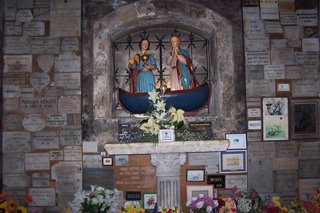 Today the pilgrimage for Sainte Marie Jacobé occurs each year on the 25th of May, while Marie Salomé’s is on the Sunday closest to 22 October. The statue of the two Maries
Today the pilgrimage for Sainte Marie Jacobé occurs each year on the 25th of May, while Marie Salomé’s is on the Sunday closest to 22 October. The statue of the two Maries
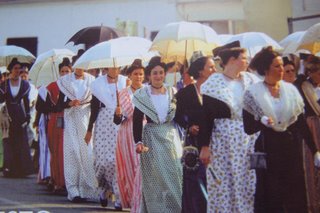
is escorted to the sea by the “Gardians” – Camargue cowboys – and by “les Arlésiennes – young women (traditionally virgins) wearing women’s clothing for the first time.
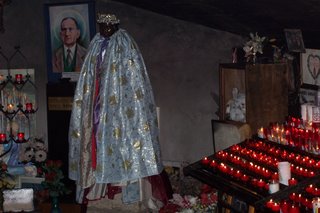 During the May pilgrimage thousands of Gypsies gather for about 10 days from throughout Europe (Roms, Manouches, Tsiganes) and on May 24th they carry the statue of Sainte Sara, their patron Saint to the sea.
During the May pilgrimage thousands of Gypsies gather for about 10 days from throughout Europe (Roms, Manouches, Tsiganes) and on May 24th they carry the statue of Sainte Sara, their patron Saint to the sea.
The May pilgrimage has nights of music and dancing in the streets as Gypsies renew acquaintances. They can also be seen going to church led by the father of the family, followed by the children and finally the mother with her baby, carrying candles.
While we were here early in January, May certainly seems like a very interesting time, perhaps worthy of a return visit.
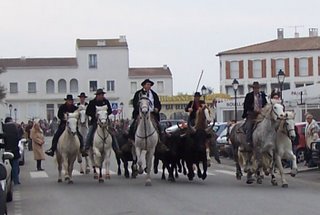 On the 2nd of January we were treated to the very fast spectacle of the “Gardians” on white horses (Camargue breed) driving 4 or 5 Camargue bulls through the streets, an annual event. Like most of the towns in this region Saintes-Maries has a bull ring.
On the 2nd of January we were treated to the very fast spectacle of the “Gardians” on white horses (Camargue breed) driving 4 or 5 Camargue bulls through the streets, an annual event. Like most of the towns in this region Saintes-Maries has a bull ring.
Religion aside, this is still a very interesting small town of 3000 permanent residents. There are a few small family run hotels, a couple of formal campgrounds, and two “aires” where a motor home can be “parked” for 6 Euros for 24 hours. There are no large apartment blocks like Cap D’Agde, and La Grande Motte, no canals like Agde and Sète and no industry like Marseille. The port is small; the one Supermarket is very small but comprehensive; there are 4 or 5 bakers; perhaps 15-20 small to medium-sized restaurants; a number of gift shops; one operational Cyber Café that serves everything from crêpes to steak and fries; kilometres and kilometres of Camargues, dykes and beaches.
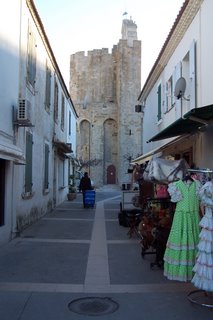 The fortified church dates from the 9th century, although much of it is from the 11th and 13th centuries. While the relics of the Maries and Sara were in large part destroyed during the aftermath of the French Revolution, some remain and are held in veneration.
The fortified church dates from the 9th century, although much of it is from the 11th and 13th centuries. While the relics of the Maries and Sara were in large part destroyed during the aftermath of the French Revolution, some remain and are held in veneration.
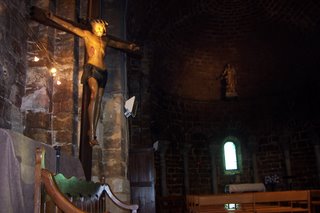
A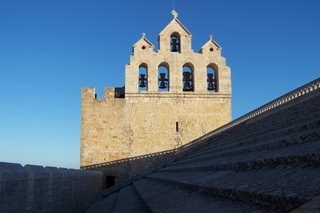 magnificent 16th century wooden crucifix of Christ hangs on one wall.
magnificent 16th century wooden crucifix of Christ hangs on one wall.
Access to the roof of the church costs 2 Euros and allows a close look at the bell tower, the stone roof tiles and the fortified wall. Pirates, primarily moors, and at various periods the Spanish and later the British navies were all threats that justified fortified churches.
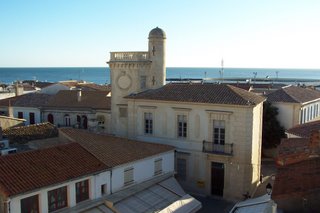
From the roof we had excellent views of the town since this is the highest structure.
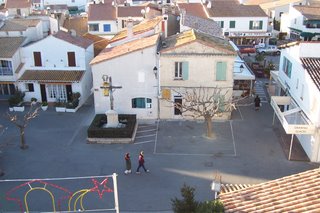
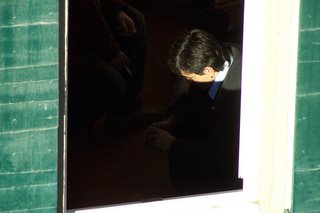
A nice balance between peaceful days and activity in winter, this town rocks with people in the summer. So take your pick.
This region of southern France, fed by the Rhône River, provides lots of evidence of early human habitation. Cave paintings dating back to 20 to 30,000 years BC were discovered by a diver near Marseilles. There is much more and consistent evidence from the Neolithic period (7000 BC) with examples of hillside settlements near Aix-en-Provence and the remains of early burial grounds in Fontvieille. A Celto-Ligurian people left evidence of fine sculptures; and Roman legions brutally ended this period in the 1st century BC. From the 6th century Phonecians brought Greek civilization to the area, first to Marseille, later in Arles – still today a well-preserved Roman town.
There is less physical evidence of the early history of the town of Saintes-Maries, not surprising given its location on the far less stable land of the Camargue. Traditional stories of the region tell us that Marie Jacobé, the aunt of Jesus, and Marie Salomé, the mother of the sons of Zébédée, arrived here during the persecution and expulsion of Christians from Judea (Palestine). According to the Scripture of Luke (8:1-3), Jesus accepted women disciples, among them Marie Jacobé and Marie Salomé. Mark (5:40-41) tells us that the two Mary’s followed Jesus into Galilee and served him there. Mark tells us also (15:47) that along with Mary Magdalene, they embalmed the body of Jesus and were amongst the first to hear of his resurrection.
Following their expulsion they landed near here with Mary Magdalene, Lazarus (and in some stories with Sara, the servant of Marie Jacobé and Marie Salomé. They remained in this coastal area and Christianized the local population, including Romans resident here and Gypsies of the region. One regional story suggests that Sainte Sara was not the servant of the two Maries but rather the Gypsy Queen of the region who was baptised by the Maries.
In 1448 bones were discovered in the crypt of the church and analysis at that time determined that they were from the 1st century after Christ and of the body type found in the holy lands.
As a result of this history, pilgrimages have played, and continue to play, a significant role in Saintes-Maries-de-la-Mer. Beginning in the 6th century pilgrims arrived regularly to honour the relics of the two Maries. Often a pilgrimage here formed part of a larger one to Compostella (made famous in modern North America by Shirley MacLean’s book).
 Today the pilgrimage for Sainte Marie Jacobé occurs each year on the 25th of May, while Marie Salomé’s is on the Sunday closest to 22 October. The statue of the two Maries
Today the pilgrimage for Sainte Marie Jacobé occurs each year on the 25th of May, while Marie Salomé’s is on the Sunday closest to 22 October. The statue of the two Maries
is escorted to the sea by the “Gardians” – Camargue cowboys – and by “les Arlésiennes – young women (traditionally virgins) wearing women’s clothing for the first time.
 During the May pilgrimage thousands of Gypsies gather for about 10 days from throughout Europe (Roms, Manouches, Tsiganes) and on May 24th they carry the statue of Sainte Sara, their patron Saint to the sea.
During the May pilgrimage thousands of Gypsies gather for about 10 days from throughout Europe (Roms, Manouches, Tsiganes) and on May 24th they carry the statue of Sainte Sara, their patron Saint to the sea.The May pilgrimage has nights of music and dancing in the streets as Gypsies renew acquaintances. They can also be seen going to church led by the father of the family, followed by the children and finally the mother with her baby, carrying candles.
While we were here early in January, May certainly seems like a very interesting time, perhaps worthy of a return visit.
 On the 2nd of January we were treated to the very fast spectacle of the “Gardians” on white horses (Camargue breed) driving 4 or 5 Camargue bulls through the streets, an annual event. Like most of the towns in this region Saintes-Maries has a bull ring.
On the 2nd of January we were treated to the very fast spectacle of the “Gardians” on white horses (Camargue breed) driving 4 or 5 Camargue bulls through the streets, an annual event. Like most of the towns in this region Saintes-Maries has a bull ring.Religion aside, this is still a very interesting small town of 3000 permanent residents. There are a few small family run hotels, a couple of formal campgrounds, and two “aires” where a motor home can be “parked” for 6 Euros for 24 hours. There are no large apartment blocks like Cap D’Agde, and La Grande Motte, no canals like Agde and Sète and no industry like Marseille. The port is small; the one Supermarket is very small but comprehensive; there are 4 or 5 bakers; perhaps 15-20 small to medium-sized restaurants; a number of gift shops; one operational Cyber Café that serves everything from crêpes to steak and fries; kilometres and kilometres of Camargues, dykes and beaches.
 The fortified church dates from the 9th century, although much of it is from the 11th and 13th centuries. While the relics of the Maries and Sara were in large part destroyed during the aftermath of the French Revolution, some remain and are held in veneration.
The fortified church dates from the 9th century, although much of it is from the 11th and 13th centuries. While the relics of the Maries and Sara were in large part destroyed during the aftermath of the French Revolution, some remain and are held in veneration.
A
 magnificent 16th century wooden crucifix of Christ hangs on one wall.
magnificent 16th century wooden crucifix of Christ hangs on one wall.Access to the roof of the church costs 2 Euros and allows a close look at the bell tower, the stone roof tiles and the fortified wall. Pirates, primarily moors, and at various periods the Spanish and later the British navies were all threats that justified fortified churches.

From the roof we had excellent views of the town since this is the highest structure.


A nice balance between peaceful days and activity in winter, this town rocks with people in the summer. So take your pick.


<< Home